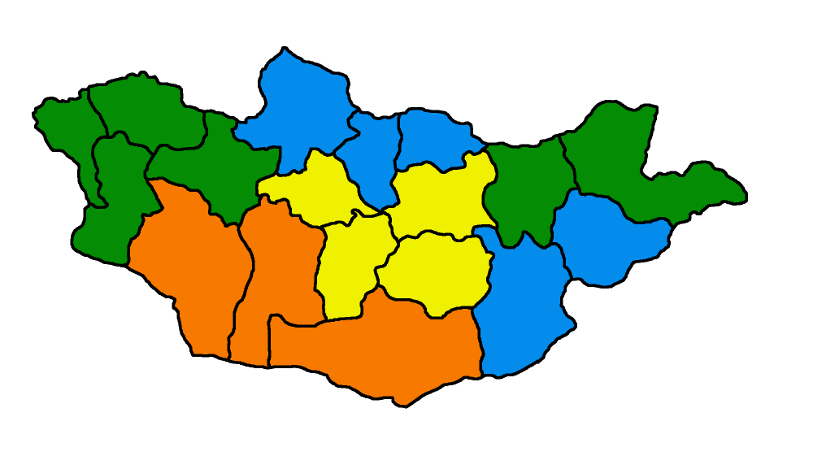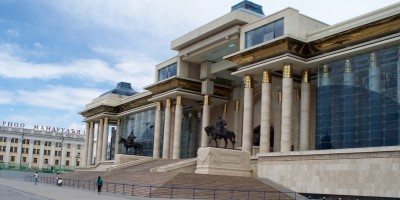The last parliamentary election in 2012 introduced a proportional system of allocating 28 of 76 seats in parliament. These seats were filled based on the proportion of votes each party received nationally using a ranked list of candidates selected by each party.
The threshold for selecting from a list was a party receiving at least 5 percent of the vote. The remaining 48 seats where allocated through popular elections in 26 districts. The primary justification for introducing the hybrid proportional-popular election system was to make elections fairer by reducing the representative imbalance between Ulaanbaatar and rural districts. Ulaanbaatar districts were under-represented and rural districts were over-represented in the allocation of seats in previous parliaments. Moreover, the Democratic Party (DP) was seen as being more popular in Ulaanbaatar districts and therefore at a disadvantage to the Mongolian People’s Party (MPP) which was seen as more popular in rural districts. There was some truth in these perceptions, but did the hybrid system increase fairness in the elections?
In one respect, I would argue no. The law created a special class of 28 parliament members who are effectively unaccountable to the electorate. This is because where a candidate appears on the ranked list is determined by the party. Thus politicians who lead parties that can garner at least 5 percent of the vote can guarantee their own re-election over and over. It creates a potentially perverse incentive to make decisions based on what keeps a politician at the top of the party list rather than on what is broadly supported by the public or constituents in a district. Of course, I would like to think what is supported by the party and public are not mutually exclusive policy domains, but the ranked list system removes the risk of direct electoral defeat for party leaders leading their parties in unpopular or unproductive directions. Of course, this can be accomplished another way by having a leader stand for election in a district “safe” for the party, but there is still a risk that even a “safe” seat can be lost if a leader does not effectively balance the party’s desires against public expectations. For the two major parties DP and MPP, which can usually garner at least 30 percent of the vote, the ranked party list removes all risk of party leadership having to face voters directly.
But, that is only one half of why I would argue the law did not increase fairness in the elections. The standard I am imposing here is that each voter’s vote has equal or near equal value to all other voters’ votes. In other words, my vote provides me the same right to select representation as everyone else. The Ulaanbaatar and rural district imbalance referred to above is an example of an average voter in a rural district having the ability to select more representation than an average voter in an Ulaanbaatar district. If districts were distributed evenly based on voter population, then roughly one vote in Ulaanbaatar would be worth one vote in a rural district in terms of potential representation in parliament.
Using voter registration data for each district in the 2008 and 2012 elections, I made a comparison on this basis to see if the new election law corrected the imbalance, if even marginally.1 The chart below shows the relative power of a vote in each district with the difference column showing whether the district became more equitable (+) or less equitable (-) for a single voter between the two elections. The baseline comparison assumes a system in which each seat in parliament represents an equal portion of the national voter population. In 2008 that was 76 seats distributed over 1,542,617 voters, or 20,297 voters per seat. In 2012 it was 48 seats distributed over 1,836,548 voters, or 38,261 voters per seat. The least equitable districts in both directions are highlighted in red.

In 2012 voters in Zavkhan (District 9) enjoyed the most voting power in the country. A vote in that district had a relative power of 1.71 votes compared to the baseline. Voters in Bayanzurkh in Ulaanbaatar (District 22) had the least voting power. A vote in that district was worth 0.55 votes in terms of its potential power to select representation. Another way to look at it is people in Zavkhan were able to select more than three times the representation in parliament than people in Bayanzurkh. Half the districts had increases and half had decreases in voter equity on this basis, but it’s not clear from the chart if that resulted in an overall improvement in 2012. The graph below shows voting power in ascending order between the two elections. If there was an improvement, we would expect to see a shallower line closer to the horizontal line spanning the value 1 on the “relative vote value” axis for 2012 than in 2008. In the graph, it seems overall the imbalance got worse, especially in districts that were already over-represented. This is not surprising, I suppose, given that the number of seats allocated for direct elections dropped from 76 to 48 in 2012 potentially accentuating the imbalance between Ulaanbaatar and rural districts.

The standard I am using to measure fairness is not necessarily an aspect of other democracies. A colleague of mine pointed out that in the United Kingdom the imbalance and inequity of the election system there is well known and documented, and yet there has been slow progress in correcting the problem. A great website here advocates for greater fairness and lets you see what votes are worth in terms of representation in different UK constituencies. Some constituencies are truly horrifying. And, let’s not even start talking about gerrymandering in the US. This is something that has been written about extensively, and depresses me to no end as a registered voter there. Imbalances and inequity are problems faced by any democracy in which political parties have a role in deciding details of the election system, which, of course, is the way it is in most democracies. That said, even though democracies can and do function with this sort of unfairness, it still shouldn’t stop us from questioning whether things could be fairer.
In that frame of mind, I attempted to redistribute the districts in the country using available voter data to reduce the inequity between districts. I constructed districts that produce roughly equivalent relative vote values of one vote per voter. I used voter data rather than population data because voter registration is compulsory in Mongolia, so all people 18 years and older prior to election day should be adequately represented in the numbers. The map I came up with below has 12 districts with seats in parliament allocated proportional to the number of voters in each district. The map further shows the difference between the “idealized” allocation versus the actual allocation of representatives in the 2008-2012 parliament. Ulaanbaatar districts have greater representation and most of the rural districts have less under this redistricting, and voters in every district have voting power roughly equal to voters in other districts. The most powerful district has votes worth 1.13 (Southeast District) and the least powerful district has votes worth 0.92 (UB-4).

Graphing the derived voting power data with the actual 2008 and 2012 vote values, we see the new districts in the map produce a more equitable line running closer to the “relative vote value” of 1 in the graph below. This is a rather blunt analysis, so there are lots of reasons to argue why this sort of map would not work in practice. However, the point is to demonstrate that reworking the districts to introduce greater voter equity is possible while still respecting established administrative borders.

After going through all the trouble of creating a new district map, I decided to have some fun and dabble in a counter-factual analysis of how the 2012 election would have turned out with 76 direct elections in these 12 districts rather than the proportional-popular system actually used. Again, using the voting data from the election, I allocated seats by the proportion of votes each party received in each district. I set a threshold of a party needing to receive at least 50 percent of the votes a single seat in parliament represented, and assigned seats using the same basic whole-number-then-decimal ranking system used to assign the 28 party list seats under the current election law. For example, a rank of 2.6789 and a rank of 3.8999 competing for 6 seats would lead to a distribution of 2 and 4 seats, respectively. The first would get 2 seats and the second would get 3 seats based on their rank whole numbers. After comparing the decimal numbers, the latter would get one additional seat because 8999 is larger than 6789. The chart below shows the difference between the actual election and the counter-factual “idealized” election using the 12 districts.

The result leads to a slight redistribution of seats from the DP to the “Justice Coalition” comprising the Mongolian People’s Revolutionary Party (MPRP) and Mongolian National Democratic Party (MNDP).2 It’s not a hugely different outcome given that the DP and MPRP-MNDP, along with the Civil Will-Green Party (CWGP), make up the current coalition government. As such, this outcome may not have resulted in a different Prime Minister or cabinet. However, it could have potentially shifted the balance of power enough to produce an MPP and MPRP-MNDP coalition or an DP-MPP grand coalition government. But, that’s the problem with counter-factual analyses, you can’t know what would have really happened under the different conditions.
Whether the counter-factual analysis produces better or worse results in terms of distribution of representation among the parties, I have no opinion. But, this allocation of seats is arguably more equitable in terms of a “one man, one vote” principle than the current system produced. More than one third of members of parliament were not directly elected, and the remaining members were elected under inequitable balances between districts. The 2012 election law is likely to be challenged and modified again leading up to the 2016 elections as parties jockey for advantage. Hopefully there will be an effort to make the system more equitable to voters rather than what is helpful to the parties and their leaders, but examples of democracy in other countries would suggest that kind of pursuit of fairness would make Mongolia an exception to the rule.
Footnotes
1. All data comes from the General Election Committee website at: http://www.gec.gov.mn/parliamentary_election/310/41.
2. The DP has two seats from Uvurkhangai that were won by having the victories of two MPP candidates voided on the basis of violations of the election law. The distribution in 2012 based on raw votes would have had 32 seats to DP and 28 seats to the MPP.



